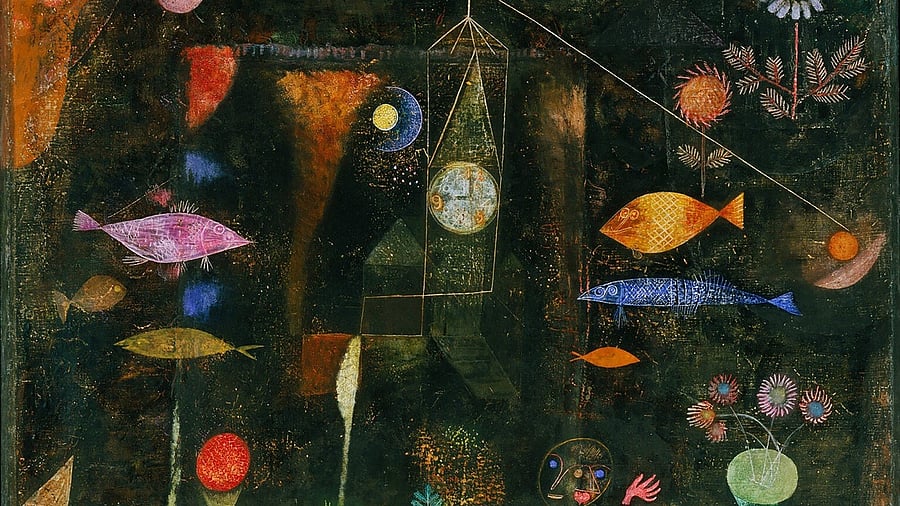
Credit: Special Arrangement
One of the most influential artists of the last century, the Swiss-born German artist Paul Klee (1879-1940), maintained good health and was physically and intellectually strong for most of his life. However, in the summer of 1935, he fell ill and required prolonged bed rest. His lungs and heart weakened swiftly; his facial skin thickened and tightened, resembling a mask. He became breathless with even mild physical exertion. He found it difficult to open his mouth or keep his monocle in place.
“Klee bore his illness with enormous courage,” writes the dermatologist and venereologist Dr Hans Suter, the author of ‘Paul Klee and His Illness: Bowed but Not Broken by Suffering and Adversity’. “He seems to have intuitively sensed at an early stage that he was suffering from a severe disease. By his own account, he wanted to remain as creatively productive as possible. He managed to do this impressively. In 1939, in the year before his death, he created no less than 1,253 works of art, mostly drawings. During the five years of his disease, he managed to complete almost 2,500 works of art, which equates to approximately a quarter of his oeuvre.”
The artist’s struggles in his final years were not solely due to illness. In 1933, the National Socialists dismissed him from his teaching position at the Düsseldorf College of Art, branding him a ‘degenerate artist’. When he returned to his hometown of Bern later that year, his exhibits were poorly received. Critics were harsh, his paintings failed to sell, causing financial hardships. When he finally succumbed to (what was later speculated to be) scleroderma on June 29, 1940, Klee was 60.
An artist’s artist
A trailblazing modernist with unrivalled creative output, Klee is often regarded as the father of abstract painting, a master of the Bauhaus, and the founder of surrealism. One of the most defining artists of the 20th century, he developed a highly sophisticated inventive language that explored the realms of abstraction and symbolism with brilliant use of signs, lines, forms, and colours. His ability to combine figurative and abstract elements in visually appealing compositions continues to inspire painters today.
In addition to his many talents as an artist, teacher, writer, and thinker, Klee had a strong interest in music, physics, mathematics, politics and the natural world. His curiosity and artistic sensitivity were boundless, making him the perfect artist’s artist. Historians reveal how he made extraordinary contributions to literature, art, and philosophical speculation, and how his mature work coincided with both the brightest and worst periods of 20th-century political and art history.
As a keen observer of nature and its elements, Klee believed that art should capture the wonders of the natural world while stimulating the feelings and imagination of the viewer. His incredibly precise and complex art blurred the barriers between fact and fiction, highlighting the mystery and beauty of nature through vivid colours, geometric patterns, and unexpected intrusions of numerals and letters.
Besides creating his works, Klee was very particular about giving each one a sharply suggestive title. The titles displayed various tones, including irony, poetry, irreverence, deadpan humour, flippancy, and melancholy. What is notable is that he very rarely repeated a title in 9,800-odd works created in his lifetime. One of his most famous quotes — ‘A line is a dot that went for a walk’ — illustrated his fascination with the line and its dynamic nature.
Visual rhythms
Music played a significant role in Klee’s art and life. His paintings included a striking visual rhythm and a range of colour accents. An accomplished violinist, he apparently practised the violin for an hour every day before beginning to paint. Klee was also an enthusiastic art teacher. “Teaching was not a sideline for Klee,” recalled eminent art critic Robert Hughes. “It was hugely important to him because it enabled him to systematise his thinking about art.” Klee’s lectures, Writings on Form and Design Theory (Schriften zur Form und Gestaltungslehre), published in English as the Paul Klee Notebooks, are held to be as important for modern art as Leonardo da Vinci’s A Treatise on Painting was for the Renaissance.
Klee was known to be a quiet, withdrawn, and thoughtful artist who preferred working in silence and isolation, in his little studio. He even seemed to distance himself from his work, speaking about it as if it belonged to someone else. He was rarely satisfied with his own work and continuously strove for greater levels of creative expression. His family life with his wife Lily (whom he married in 1906) and his son Felix was completely faultless. Curiously, death was a recurring motif in Klee’s work. Ten years before his death, the ambidextrous artist (who wrote with his right hand and painted with his left) said, “Death is nothing bad; I long ago reconciled myself to it. How do we know what is more important, our present life or what comes after? […] I won’t mind dying if I have done a few more good paintings.”